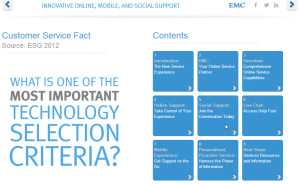The typical customer service organization today is light years away from those of 20 years ago. On the surface, things seemed much simpler back then.
A customer in need simply picked up the phone. If a series of diagnostic questions didn’t help the customer over the phone, an engineer would be dispatched. But behind the scenes, things were not so simple. Having the right expertise available at the right location and in a timely manner – without the tools and technology that we have in place today – made achieving service excellence costly and difficult.
In today’s world, that old model is intolerable for EMC and our customers. The costs are unrealistic and the service level unacceptable. Fortunately, today’s service model offers flexibility and choice for customers. Sure telephone and onsite support are still in the equation, but online, mobile, and social support tools are in the mix, in addition to a significant focus on proactive, predictive support capabilities and serviceability. This sounds more complex but service quality and fast answers are far simpler for our customers.
 In “Lessons Unlearned”, TSIA’s John Ragsdale describes an organization where support attendants would write up a “ticket” and hand it to a runner responsible for hand-delivering it to an expert to handle it. Following implementation of their first CRM system, the process changed so the attendant entered the information into the system, printed it, and handed it to the runner. Despite new system capabilities, the organization decided not to embrace all that was offered. This example seems extreme in today’s world, but years from now, so will the stories about phone being the only channel used for support.
In “Lessons Unlearned”, TSIA’s John Ragsdale describes an organization where support attendants would write up a “ticket” and hand it to a runner responsible for hand-delivering it to an expert to handle it. Following implementation of their first CRM system, the process changed so the attendant entered the information into the system, printed it, and handed it to the runner. Despite new system capabilities, the organization decided not to embrace all that was offered. This example seems extreme in today’s world, but years from now, so will the stories about phone being the only channel used for support.
My point? I find it interesting that a subset of customers limit themselves by not taking advantage of all that the new service model has to offer. EMC invested heavily in Customer Service for several years to help customers maximize the value of their EMC solutions. Many customers embrace this. As an example, approximately 75% of our service requests are opened utilizing EMC Online Support tools (web and chat), but that means about 25% are not yet – despite the numerous benefits of these channels. Likewise, as a service channel, telephone has now been surpassed in volume by Live Chat, yet some customers have not given it a try.
Where are you on the spectrum in terms of taking advantage of new service capabilities? I invite you to click on the graphic and take a look at a new eBook we have released to help you explore all that our 2013 customer service organization has to offer and to take that next step closer to easier answers.

